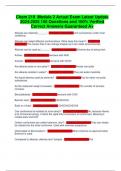Chem 219 module 2 Study guides, Class notes & Summaries
Looking for the best study guides, study notes and summaries about Chem 219 module 2? On this page you'll find 41 study documents about Chem 219 module 2.
Page 2 out of 41 results
Sort by
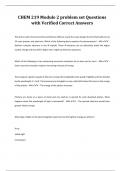
-
CHEM 219 Module 2 problem set Questions with Verified Correct Answers
- Exam (elaborations) • 9 pages • 2024
- Available in package deal
-
- $11.99
- + learn more
CHEM 219 Module 2 problem set Questions with Verified Correct Answers The atomic radii of zirconium (Zr) and hafnium (Hf) are nearly the same despite the fact that hafnium has 32 more protons and electrons. Which of the following bests explains this phenomenon? - ANS - Hafnium contains electrons in the 4f orbitals. These 4f electrons do not effectively shield the higher nuclear charge and thus Zeff is higher than might be otherwise expected. Which of the following is true concerning succ...
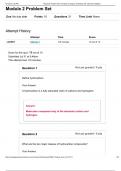
-
chem 219 Module 2 Problem Set: Principles of Organic Chemistry with Lab-2021-Gallaher Module 2 Problem Set updated and verified 2024
- Exam (elaborations) • 16 pages • 2024
- Available in package deal
-
- $7.99
- + learn more
chem 219 Module 2 Problem Set: Principles of Organic Chemistry with Lab-2021-Gallaher Module 2 Problem Set updated and verified 2024
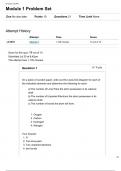
-
CHEM 219 Module 1 Problem Set Principles of Organic Chemistry with Lab Gallaher Portage Learning & CHEM 219 Module 2 Problem Set Principles of Organic Chemistry with Lab Gallaher Portage Learning.
- Package deal • 2 items • 2024
-
- $19.49
- + learn more
CHEM 219 Module 1 Problem Set Principles of Organic Chemistry with Lab Gallaher Portage Learning & CHEM 219 Module 2 Problem Set Principles of Organic Chemistry with Lab Gallaher Portage Learning.
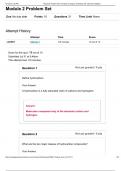
-
chem 219 Module 2 Problem Set: Principles of Organic Chemistry with Lab-2021-Gallaher Module 2 Problem Set
- Exam (elaborations) • 16 pages • 2024
- Available in package deal
-
- $7.99
- + learn more
chem 219 Module 2 Problem Set: Principles of Organic Chemistry with Lab-2021-Gallaher Module 2 Problem Set
Chem 219 Module 2 Actual Exam Latest Update Questions and 100% Verified Correct Answers Guaranteed A+
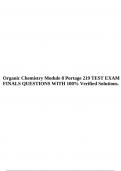
-
Organic Chemistry Module 8 Portage 219 TEST EXAM FINALS QUESTIONS WITH 100% Verified Solutions.
- Exam (elaborations) • 20 pages • 2024
-
- $11.99
- + learn more
Organic Chemistry Module 8 Portage 219 TEST EXAM FINALS QUESTIONS WITH 100% Verified Solutions. Polymer large molecule made by repetitive linking of smaller units (monomers) Macromolecule very large molecule composed of thousands of covalently bonded atoms (ex: polymer) 1. natural (in nature) 2. synthetic (in lab) two ways polymers are made rubber, carbs: starch & cellulose, proteins, nucleic acids DNA, RNA natural polymers nylon, teflon, styrofoam, polyethylene, Dacron, synthetic pol...
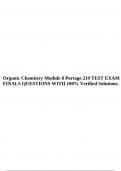
-
Organic Chemistry Module 8 Portage 219 TEST EXAM FINALS QUESTIONS WITH 100% Verified Solutions.
- Exam (elaborations) • 20 pages • 2024
-
- $11.99
- + learn more
Organic Chemistry Module 8 Portage 219 TEST EXAM FINALS QUESTIONS WITH 100% Verified Solutions. Polymer large molecule made by repetitive linking of smaller units (monomers) Macromolecule very large molecule composed of thousands of covalently bonded atoms (ex: polymer) 1. natural (in nature) 2. synthetic (in lab) two ways polymers are made rubber, carbs: starch & cellulose, proteins, nucleic acids DNA, RNA natural polymers nylon, teflon, styrofoam, polyethylene, Dacron, synthetic pol...
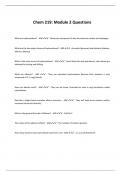
-
Chem 219: Module 2 Questions
- Exam (elaborations) • 17 pages • 2024
- Available in package deal
-
- $10.99
- + learn more
Chem 219: Module 2 Questions What are hydrocarbons? - ANS - Molecules composed of only the elements carbon and hydrogen What are the two major classes of hydrocarbons? - ANS - Aromatic (benzene) and aliphatic (alkanes, alkenes, alkynes) What is the main source of hydrocarbons? - ANS - Fossil fuels like coal, petroleum, and natural gas obtained by mining and drilling. What are Alkanes? - ANS - They are saturated hydrocarbons because their skeleton is only composed of C-C single ...
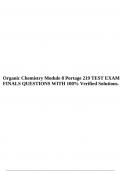
-
Organic Chemistry Module 8 Portage 219 TEST EXAM FINALS QUESTIONS WITH 100% Verified Solutions.
- Exam (elaborations) • 20 pages • 2024
-
- $11.99
- + learn more
Organic Chemistry Module 8 Portage 219 TEST EXAM FINALS QUESTIONS WITH 100% Verified Solutions. Polymer large molecule made by repetitive linking of smaller units (monomers) Macromolecule very large molecule composed of thousands of covalently bonded atoms (ex: polymer) 1. natural (in nature) 2. synthetic (in lab) two ways polymers are made rubber, carbs: starch & cellulose, proteins, nucleic acids DNA, RNA natural polymers nylon, teflon, styrofoam, polyethylene, Dacron, synthetic pol...
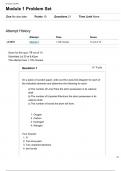
-
CHEM 219 Module 1 Problem Set Principles of Organic Chemistry with Lab Gallaher Portage Learning.
- Exam (elaborations) • 18 pages • 2024
- Available in package deal
-
- $11.99
- + learn more
CHEM 219 Module 1 Problem Set Principles of Organic Chemistry with Lab Gallaher Portage Learning. Score for this quiz: 10 out of 10 Submitted Jul 25 at 8:42pm This attempt took 1,135 minutes. Question 1 0 / 0 pts Your Answer: On a piece of scratch paper, write out the Lewis Dot Diagram for each of the indicated elements and determine the following for each: a) The number of Lone Pairs the atom possesses in its valence shell. b) The number of Unpaired Electrons the atom possesses in its...

